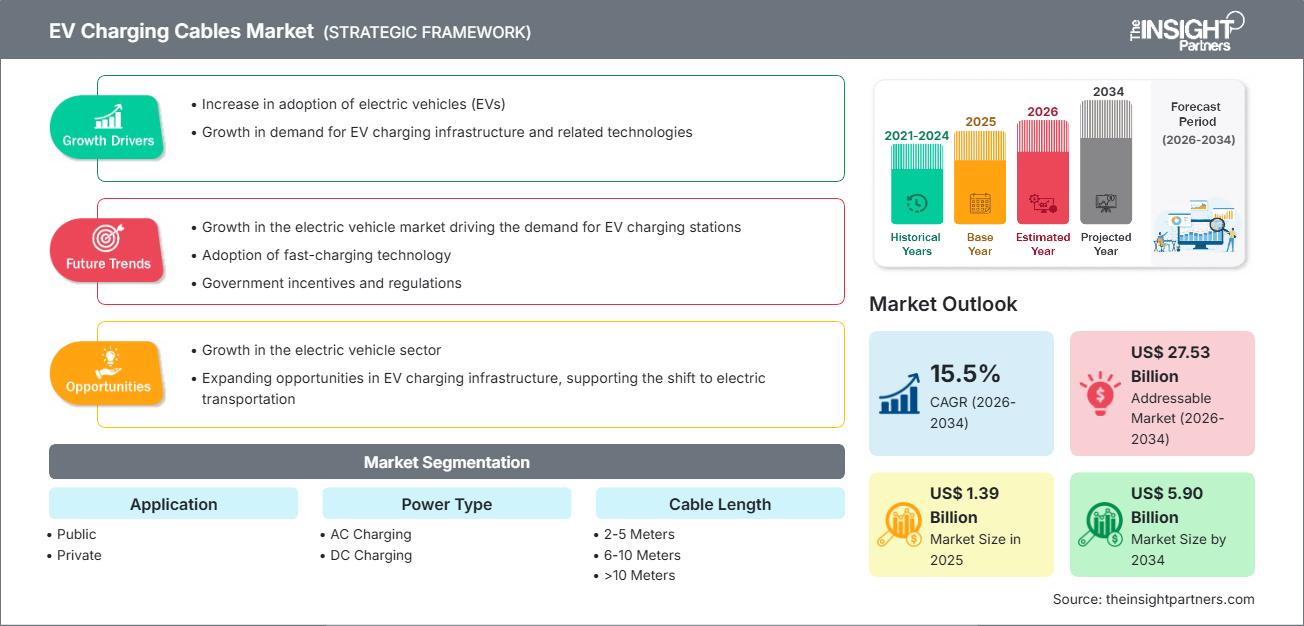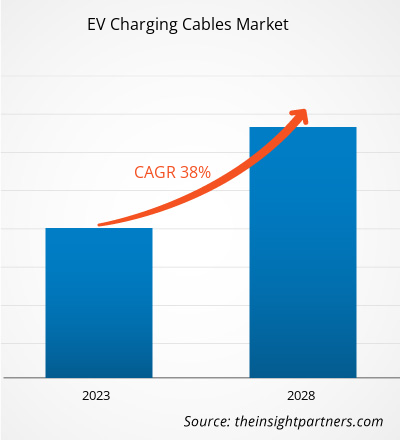Es wird erwartet, dass der Markt für Ladekabel für Elektrofahrzeuge von 1,39 Milliarden US-Dollar im Jahr 2025 auf 5,90 Milliarden US-Dollar im Jahr 2034 anwachsen wird, was einer durchschnittlichen jährlichen Wachstumsrate (CAGR) von 15,5 % im Prognosezeitraum entspricht.
Marktanalyse für Ladekabel für Elektrofahrzeuge
Die rasant zunehmende Verbreitung von Elektrofahrzeugen, steigende Investitionen in die Ladeinfrastruktur und die regulatorische Unterstützung durch Regierungen verschiedener Regionen treiben den Markt für Ladekabel für Elektrofahrzeuge an, der ein starkes Wachstum verzeichnet. Die steigende Nachfrage nach Hochleistungsladung, längeren Kabeln und fortschrittlichen Isoliermaterialien verstärkt dieses Wachstum zusätzlich. Anreize im Rahmen der Klimapolitik und Vorgaben zum Ausbau der Ladeinfrastruktur für Elektrofahrzeuge fördern die Nachfrage nach Ladelösungen sowohl für Privathaushalte als auch für den öffentlichen Raum.
Der Übergang zu Gleichstrom-Schnellladung und ultraschneller Ladung wird auch die Produktinnovation vorantreiben und hochentwickelte Kabel mit hoher Strombelastbarkeit erfordern. Darüber hinaus wird die Integration intelligenter Funktionen sowie Sicherheitsverbesserungen wie Temperatursensoren und verstärkte Ummantelungen die Verbreitung von Premium-Ladekabeln für Elektrofahrzeuge weiter fördern. Da Ladenetzbetreiber und Elektrofahrzeughersteller ihre Kapazitäten rasant ausbauen, investieren Kabelhersteller entsprechend massiv in Forschung und Entwicklung, um skalierbare, leistungsstarke und sichere Kabellösungen zu unterstützen.
Überblick über den Markt für Ladekabel für Elektrofahrzeuge
Ladekabel für Elektrofahrzeuge sind entscheidende Komponenten, die elektrische Energie von Ladestationen zu den Batterien der Elektrofahrzeuge übertragen. Die Kabel unterscheiden sich je nach Ladeleistung (Wechsel- oder Gleichstrom), Länge, Steckertyp, Mantelmaterial und Lademodus (Modus 1/2/3/4). Sie werden sowohl für private (häusliche) als auch für öffentliche Ladestationen verwendet. Hochwertige Kabel verbessern die Sicherheit, reduzieren Verluste und unterstützen die Schnellladeinfrastruktur, die mit der zunehmenden Verbreitung von Elektrofahrzeugen immer wichtiger wird.
Passen Sie diesen Bericht Ihren Anforderungen an.
Sie erhalten eine kostenlose Anpassung aller Berichte – einschließlich Teilen dieses Berichts, Länderanalysen und Excel-Datenpaketen – sowie attraktive Angebote und Rabatte für Start-ups und Universitäten.
Markt für Ladekabel für Elektrofahrzeuge: Strategische Einblicke

-
Ermitteln Sie die wichtigsten Markttrends dieses Berichts.Diese KOSTENLOSE Probe beinhaltet eine Datenanalyse, die von Markttrends bis hin zu Schätzungen und Prognosen reicht.
Markttreiber und Chancen für Ladekabel für Elektrofahrzeuge
Markttreiber:
- Schnelle Einführung von Elektrofahrzeugen und Ausbau der Ladeinfrastruktur: Die weltweit wachsende Anzahl von Elektrofahrzeugen erhöht die Nachfrage nach hochwertigen und leistungsstarken Ladekabeln.
- Staatliche Anreize und Strategien für saubere Mobilität: Subventionen, Steuervorteile und Regulierungen zur Förderung des Ausbaus der Ladeinfrastruktur unterstützen das Marktwachstum.
- Bessere Ladetechnologie: Der Übergang zu DC-Schnelllade- und ultraschnellen Ladegeräten führt zu einer höheren Nachfrage nach Spezialkabeln mit hoher Kapazität.
- Anforderungen an Sicherheit und Langlebigkeit: Strenge Sicherheitsanforderungen begünstigen den Einsatz von Temperaturüberwachungskabeln mit verstärkten Mänteln und feuerbeständigen Materialien.
Marktchancen:
- Expansion in Schwellenländer: Die rasante Verbreitung von Elektrofahrzeugen in Regionen wie dem asiatisch-pazifischen Raum bietet große Wachstumschancen.
- Intelligente und verstärkte Kabeldesigns: Innovationen bei schnittfesten, selbstüberwachenden oder flüssigkeitsgekühlten Kabeln – insbesondere für das Schnellladen mit Gleichstrom – können Premiumsegmente erschließen. Führende Hersteller von Ladeinfrastruktur für Elektrofahrzeuge beginnen beispielsweise gerade erst, schnittfeste Designs auf den Markt zu bringen.
- Integration von Energiemanagementsystemen: Mit Sensoren oder Konnektivität ausgestattete Kabel ermöglichen V2G-Anwendungen wie vorausschauende Wartung oder netzgesteuertes Laden.
Marktbericht für Ladekabel für Elektrofahrzeuge: Segmentierungsanalyse
Der Markt für Ladekabel für Elektrofahrzeuge ist wie folgt segmentiert:
Auf Antrag:
- Öffentliche Gebühren
- Privat (Wohnbereich)
Nach Energieart:
- AC-Laden
- Gleichstromladung
Nach Kabellänge:
- 2–5 Meter
- 6–10 Meter
- >10 Meter
Nach Ladezustand:
- Stufe 1
- Stufe 2
- Stufe 3
Nach Geographie:
- Nordamerika
- Europa
- Asien-Pazifik
- Süd- und Mittelamerika
- Naher Osten und Afrika
Markteinblicke für Ladekabel für Elektrofahrzeuge
Die regionalen Trends und Einflussfaktoren auf den Markt für Ladekabel für Elektrofahrzeuge im gesamten Prognosezeitraum wurden von den Analysten von The Insight Partners eingehend erläutert. Dieser Abschnitt behandelt außerdem die Marktsegmente und die geografische Verteilung des Marktes für Ladekabel für Elektrofahrzeuge in Nordamerika, Europa, Asien-Pazifik, dem Nahen Osten und Afrika sowie Süd- und Mittelamerika.
Umfang des Marktberichts zu Ladekabeln für Elektrofahrzeuge
| Berichtattribute | Details |
|---|---|
| Marktgröße im Jahr 2025 | 1,39 Milliarden US-Dollar |
| Marktgröße bis 2034 | 5,90 Milliarden US-Dollar |
| Globale durchschnittliche jährliche Wachstumsrate (2026 - 2034) | 15,5 % |
| Historische Daten | 2021-2024 |
| Prognosezeitraum | 2026–2034 |
| Abgedeckte Segmente |
Durch Bewerbung
|
| Abgedeckte Regionen und Länder |
Nordamerika
|
| Marktführer und wichtige Unternehmensprofile |
|
Marktdichte der Akteure im Bereich der Ladekabel für Elektrofahrzeuge: Auswirkungen auf die Geschäftsdynamik verstehen
Der Markt für Ladekabel für Elektrofahrzeuge wächst rasant, angetrieben durch die steigende Nachfrage der Endverbraucher. Gründe hierfür sind unter anderem sich wandelnde Verbraucherpräferenzen, technologische Fortschritte und ein wachsendes Bewusstsein für die Vorteile des Produkts. Mit steigender Nachfrage erweitern Unternehmen ihr Angebot, entwickeln innovative Lösungen, um den Kundenbedürfnissen gerecht zu werden, und nutzen neue Trends, was das Marktwachstum zusätzlich beflügelt.

- Verschaffen Sie sich einen Überblick über die wichtigsten Akteure auf dem Markt für Ladekabel für Elektrofahrzeuge.
Marktanteilsanalyse für Ladekabel für Elektrofahrzeuge nach Regionen
- Der asiatisch-pazifische Raum dürfte aufgrund der rasant steigenden Verbreitung von Elektrofahrzeugen, insbesondere in China und Indien, sowie der anhaltenden Investitionen in die Infrastruktur eine der am schnellsten wachsenden Regionen sein.
- Nordamerika wird durch den starken Ausbau des öffentlichen Ladenetzes und staatliche Programme für die Infrastruktur von Elektrofahrzeugen angetrieben.
- Europa wird beeinflusst von strengen Emissionsvorschriften, Zielen für grüne Mobilität und dem Ausbau von Schnellladekorridoren.
- Aufstrebende Regionen wie Süd- und Mittelamerika sowie der Nahe Osten und Afrika bieten Chancen durch die zunehmende Verbreitung von Elektrofahrzeugen und Investitionen in die Infrastruktur, obwohl sie derzeit noch einen geringeren Marktanteil haben.
Marktdichte der Akteure im Bereich der Ladekabel für Elektrofahrzeuge: Auswirkungen auf die Geschäftsdynamik verstehen
Der Markt ist hart umkämpft und wird von zahlreichen globalen und regionalen Anbietern dominiert. Führende Kabelhersteller konzentrieren sich darauf, ihre Produkte durch Merkmale wie verstärkte Ummantelungen, Hochstrom-Schnellladefunktionen und intelligente Kabelüberwachungssysteme zu differenzieren.
Zu den wichtigsten Wettbewerbshebeln gehören:
- Innovationen bei Hochleistungs-Gleichstrom-Schnellladekabeln
- Sicherheitsmerkmale und Langlebigkeitsmerkmale (z. B. Schnittfestigkeit, Hitzeschutz)
- Kompatibilität mit modularen und standardisierten Steckverbindern (z. B. CCS, Typ 2)
- Kosteneffiziente Produktion und Skalierung zur Bedienung sowohl des volumenstarken Privatkundenmarktes als auch leistungsstarker öffentlicher Ladenetze
Markt für Ladekabel für Elektrofahrzeuge – Wichtigste Unternehmen
- Coroplast-Gruppe
- TE-Konnektivität
- Phoenix Contact (Elektromobilität)
- Sinbon Electronics Co., Ltd.
- Besen International Group Co., Ltd.
- Dyden Corporation
- General Cable Technologies Corporation
- Systems Wire & Cable
- Teison Energy Technology Co., Ltd.
Weitere im Rahmen der Studie analysierte Unternehmen:
- Aptiv
- Leoni AG
- Brugg eConnect
- Ionity GmbH
- Chengdu Khons Technology Co., Ltd.
Marktneuigkeiten und aktuelle Entwicklungen im Bereich Ladekabel für Elektrofahrzeuge
- Schnittfeste Kabel von ChargePoint: ChargePoint reagiert auf Kabeldiebstahl mit der Einführung schnittfester Ladekabel für Elektrofahrzeuge, die mit strategisch platzierten Stahlverstärkungen und Echtzeit-Manipulationserkennung ausgestattet sind.
- Politisch getriebenes Wachstum: Verschiedene nationale Regierungen bieten Anreize für den Ausbau der Ladeinfrastruktur für Elektrofahrzeuge und erhöhen damit die Nachfrage nach hochwertigen Ladekabeln.
Marktbericht zu Ladekabeln für Elektrofahrzeuge: Abdeckung und Ergebnisse
Der Bericht „Marktgröße und Prognose für Ladekabel für Elektrofahrzeuge (2022–2028)“ von The Insight Partners umfasst Folgendes:
- Marktgröße und Prognosen auf globaler, regionaler und Länderebene
- Markttrends, Treiber, Hemmnisse und wichtige Chancen
- Detaillierte PEST- und SWOT-Analysen
- Wettbewerbsanalyse, einschließlich Marktkonzentration, Heatmap-Analyse, Hauptakteure und aktuelle Entwicklungen
- Detaillierte Unternehmensprofile der führenden Kabelhersteller
- Historische Analyse (2 Jahre), Basisjahr, Prognose (7 Jahre) mit CAGR
- PEST- und SWOT-Analyse
- Marktgröße Wert/Volumen – Global, Regional, Land
- Branchen- und Wettbewerbslandschaft
- Excel-Datensatz
Aktuelle Berichte
Erfahrungsberichte
Grund zum Kauf
- Fundierte Entscheidungsfindung
- Marktdynamik verstehen
- Wettbewerbsanalyse
- Kundeneinblicke
- Marktprognosen
- Risikominimierung
- Strategische Planung
- Investitionsbegründung
- Identifizierung neuer Märkte
- Verbesserung von Marketingstrategien
- Steigerung der Betriebseffizienz
- Anpassung an regulatorische Trends






















 Kostenlose Probe anfordern für - Markt für Ladekabel für Elektrofahrzeuge
Kostenlose Probe anfordern für - Markt für Ladekabel für Elektrofahrzeuge